
The Delmarva Peninsula, or simply Delmarva, is a large peninsula on the East Coast of the United States, occupied by Delaware and parts of the Eastern Shores of Maryland and Virginia. The peninsula is 170 miles (274 km) long. In width, it ranges from 70 miles (113 km) near its center, to 12 miles (19 km) at the isthmus on its northern edge, to less near its southern tip of Cape Charles. It is bordered by the Chesapeake Bay on the west, the Delaware River, Delaware Bay, and the Atlantic Ocean on the east, and the Elk River and its isthmus on the north.
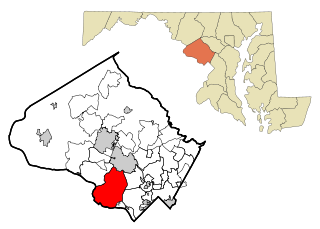
Potomac is a census-designated place (CDP) in Montgomery County, Maryland, United States, named for the nearby Potomac River. In 2013, CNNMoney listed Potomac as the most affluent town in all the United States, based on median household income. Potomac is also the seventh-most top-educated American small town according to Forbes. Bloomberg Businessweek labeled Potomac as the twenty-ninth-richest zip code in the United States in 2011, stating that it had the largest population of any U.S. town with a median income of more than $240,000. In 2012, The Higley Elite 100 published a list of highest-income neighborhoods by mean household income, which included four neighborhoods in Potomac; one of these neighborhoods, "Carderock-The Palisades" was ranked the highest-income neighborhood in the United States, followed by "Beverly Hills-North of Sunset" in Beverly Hills, California, and "Swinks Mill-Dominion Reserve" of McLean, Virginia. More recently, two Potomac neighborhoods were ranked among the ten wealthiest neighborhoods in the country by CNBC in 2014. In 2018, data from the American Community Survey revealed that Potomac was the sixth-wealthiest city in the United States. Many Potomac residents work in nearby Washington, D.C.

Red Lion is a borough in York County, Pennsylvania, settled in 1852 and incorporated on January 16, 1880. The population was 6,373 at the 2010 census.
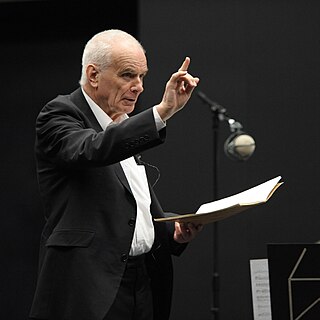
Sir Peter Maxwell Davies was an English composer and conductor. In 2004 he was made Master of the Queen's Music.

Dame Carolyn Emma Kirkby, is an English soprano and one of the world's most renowned early music specialists. She has sung on over 100 recordings.

Harpers Ferry National Historical Park is located at the confluence of the Potomac and Shenandoah rivers in and around Harpers Ferry, West Virginia. The park includes land in the Shenandoah Valley in Jefferson County, West Virginia; Washington County, Maryland and Loudoun County, Virginia. The park is managed by the National Park Service, an agency of the U.S. Department of the Interior. Originally designated Harpers Ferry National Monument in 1944, the park was declared a National Historical Park by the U.S. Congress in 1963. The park includes the historic town of Harpers Ferry, notable as a center of 19th-century industry and as the scene of John Brown's failed abolitionist uprising. Consisting of almost 4,000 acres (16 km2), it includes the site of which Thomas Jefferson once wrote, "The passage of the Potomac through the Blue Ridge is perhaps one of the most stupendous scenes in Nature" after visiting the area in 1783. Due to a mixture of historical events and ample recreational opportunities, all within 50 miles (80 km) of Washington, D.C., the park was listed on the National Register of Historic Places on October 15, 1966. The Park's Superintendent is presently Tyrone Brandyburg.

Piscataway is an unincorporated community in Prince George's County, Maryland, United States. It is one of the oldest European-colonized communities in the state. The Piscataway Creek provided sea transportation for export of tobacco. It is located near the prior Piscataway tribe village of Kittamaqundi.

We-Sorts is a name and rarely used by the current younger generation for a group of Native Americans in Maryland who are from the Piscataway tribe. The Piscataway were powerful at the time of European encounter. Many individuals with the surnames Proctor, Newman, Savoy, Queen, Butler, Thompson, Swann, Gray, and Harley claim that Native heritage. Many are notably of a mixed race between black, white and Native American. "Some members of the Piscataway Indian groups now consider the name Wesort derogatory." Historian Frank Sweet lists "Wesorts" as among a group of "derogatory epithets given by mainstream society, not self-labels". However, "Wesort" is listed as a self-identified "Other race" on the 2000 United States Census.

Highland is an unincorporated community and census-designated place in Howard County, Maryland, United States. As of the 2010 census it had a population of 1,034. It uses the 20777 zip code.

Valley Lee is an unincorporated community in St. Mary's County, Maryland, United States. The St. George's Episcopal Church was listed on the National Register of Historic Places in 1973. Another landmark of Valley Lee is the 100-year-old Russells Store, a country store, barber/beautyshop, and local tavern.
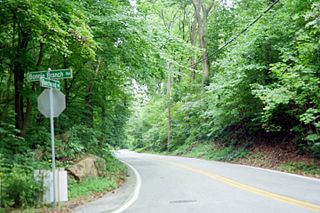
Ilchester is an unincorporated community and census-designated place in Howard County, Maryland, United States. The population was 23,476 at the 2010 census. It was named after the village of Ilchester in the English county of Somerset.
The Caledonia Opera House was a three-storey building located in small town Caledonia from the 1830s until a fire which destroyed the building in 1947.

Dayton is an unincorporated community located in Howard County, Maryland, United States.

The George Washington House, or Indian Queen Tavern, is located at Baltimore Ave., at Upshur St., in Bladensburg, Prince George's County, Maryland. It was constructed in the 1760s. The 2 1⁄2-story structure is constructed of brick Flemish bond on ends. The plan is rectangular, with a gabled roof, exterior end chimneys, gabled shingled dormers. There are first and second-story center entrances, each with a transom. There is a full-width one-story porch with balustraded deck and side entrances. The structure includes a later two-story rear addition. The structure is Georgian.

Delaware State Park is a 2,016-acre (816 ha) Ohio state park in Delaware County, Ohio in the United States. The park, town and county are named for the Delaware Indians, a Native American tribe that originally lived along the Delaware River in Pennsylvania, Delaware, New York, Maryland, Connecticut and New Jersey. The Delawares were forced west by colonial settlers and were eventually forced further west by settlers of the Northwest Territory from which Ohio was established in 1803. Delaware State Park is on U.S. Route 23 near the city of Delaware, Ohio. It is open for year-round recreation including camping, hiking, boating, hunting, fishing, and picnicking.
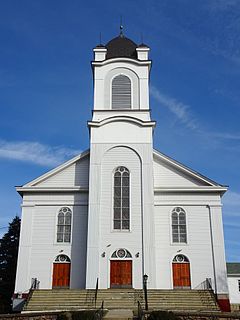
Readington Village is an unincorporated community located within Readington Township in Hunterdon County, New Jersey, United States, that is centered on the converging of Readington Road, Hillcrest Road, Centerville Road and Brookview Road. It is located on Holland Brook, originally named Amanmechunk, which means large creek in the Unami dialect. The area was inhabited by the Raritan prior to the arrival of European settlers. The Native Americans who lived near Readington Village travelled to the coast during the summer for fish and clams. Such a trip is mentioned in an Indian deed transferring lands around Holland Brook to English and Dutch settlers. The deed mentions two of the natives, who lived at Readington: Metamisco and Wataminian.
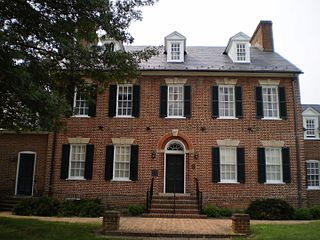
The Rossborough Inn is a historic building facing Baltimore Avenue/United States Route 1 on the eastern edge of the campus of the University of Maryland at College Park. Construction on the building began in 1798 and was completed in 1812, making it the oldest building on campus and the oldest building in the adjoining town of the City of College Park. It is built in the Federal style. The lower wings were added in 1938, as part of extensive renovations. The Rossborough Inn is listed as a historic site by the Maryland-National Capital Park and Planning Commission.

The Jamestown Opera House is a historic government building and community center in the village of Jamestown, Ohio, United States. It has been named a historic site because of its well-preserved architecture. Besides serving as a theater, the opera house has functioned as the community's village hall, its fire station, its post office, and its library.

French's Tavern, also known as Swan's Creek Plantation, Indian Camp, Harris's Store, and The Coleman Place, is a historic house and tavern located near Ballsville, Powhatan County, Virginia. The two-story, frame building complex is in five distinct sections, with the earliest dated to about 1730. The sections consist of the main block, the wing, the annex, the hyphen and galleries. It was built as the manor home for a large plantation, and operated as an ordinary in the first half of the 19th century.


















